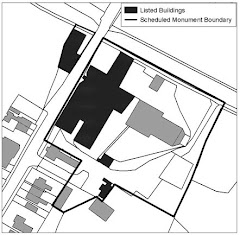 Looking north at Marston Flashes, created in 1928 by the collapse of the Adelaide Rock salt Mine. Lion Salt Works pumped brine into the Brine Tank from brine streams 150 feet below ground. The Adelaide Works mined rock salt from a Bottom bed of rock salt at 300ft.
Looking north at Marston Flashes, created in 1928 by the collapse of the Adelaide Rock salt Mine. Lion Salt Works pumped brine into the Brine Tank from brine streams 150 feet below ground. The Adelaide Works mined rock salt from a Bottom bed of rock salt at 300ft.The Trent and Mersey Canal passes along the front of the Lion Salt Works and was used to bring coal to the works, mainly from collieries in the Stoke-on-Trent area of North Staffordshire
In 1888 the Manchester Guardian described this area as a 'black country' with baked earth and sulphurous black smoke polluting the atmosphere where no trees or grass could grow.

Looking south the distant tower of St Helens Church, Witton can be seen. Between Marston and Witton there were rock salt mines which collapsed causing the road to be diverted. The collapsed mines were used as land fill sites for lime waste from the local chemical works. Ashtons and Neumans Flashes are now landscaped as a Community Woodland with footpaths and cycle ways. This is a great area for bird watching with many wading species and exotics such as black swans, egrets, grebes and last year black legged stilts.

To the south west you can see the chemical works of Brunner Mond which uses brine and salt to make soda ash and sodium bicarbonate. The works is at Winnington, but looks out over the Anderton Lift, which connects the Trent and Mersey Canal to the River weaver. the Lion Salt Works shipped salt by narrow boat along the canal to transfer salt to waiting barges where it was sailed to Liverpool Docks for export overseas.
web links to follow






No comments:
Post a Comment
Please leave your cmments about the work to restore the Lion Salt Works.